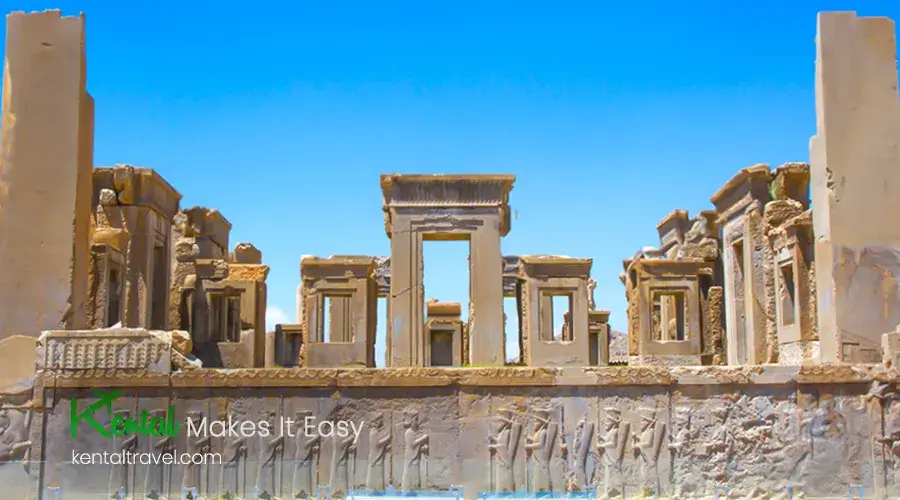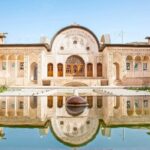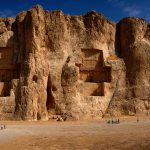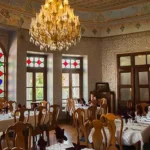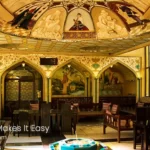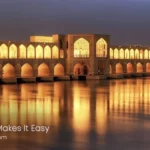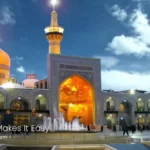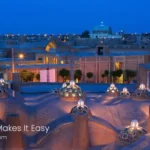When it comes to the history of a country, the most prominent distinguishing feature is often its historical structures that have endured through the ages. One of the most renowned ancient countries in the world is Iran. The ancient sites and historical attractions of Iran are countless, and according to the World Tourism Organization’s report, Iran has managed to secure the tenth position in terms of historical and ancient attractions globally. In this article by Kental Travel, we will introduce some of the most famous and remarkable Iran Historical Places.
Historical Attractions in Iran

Iran, due to its ancient and proud heritage, is replete with historical and unique sites that have no equal in the world. Every year, it attracts numerous visitors from around the globe, drawing them to its secrets. Some of Iran historical sites and artifacts date back to 4000 years before the birth of Christ. From east to west, north to south, Iran boasts a plethora of tourist attractions. This very fact sets the country apart as unique among other tourist destinations. Given the vast expanse of historical treasures in Iran, we will introduce some of the most Historical Landmarks to Visit in Iran below.
What is the historical capital of Iran?
Undoubtedly, for travelers who value history, cities like Shiraz, Kerman, Isfahan, Kermanshah, and Yazd stand out as extraordinary destinations in Iran. These cities are brimming with diverse and historically unique attractions, showcasing remnants of Iran’s ancient civilization that satisfy the curiosity of explorers. These cities bring forth the grandeur, intellect, power, and at times, finesse of past civilizations. This article highlights some of the historical sites in these cities.
historical places to visit in Iran
Pasargadae

One of the attractions that hold special significance for the people of Iran is the historical site of Pasargadae in Shiraz. This Iran historical place, also known as the mother city of Suleiman, dates back 2500 years. The Pasargadae historical complex in Shiraz was registered as the fifth recognized site with unanimous approval (100% votes) during the 28th UNESCO session in 2004 with the registration number 1106. Pasargadae is located in a valley at an altitude of 1900 meters above sea level and is surrounded by mountain walls. Its main structures include:
- A grand and splendid garden.
- Two palaces.
- A beautiful palace featuring numerous large columns.
Architectural designs from Greece, Egypt, and Mesopotamia influenced the architecture and construction of the Pasargadae Palace and its various structures. The Urartian architectural style had the greatest impact on the architecture of the Achaemenid-era structures. That’s why the architecture of Cyrus’ tomb strongly resembles the Ziggurat tomb.
Persepolis (Takht-e Jamshid)

Persepolis, also known as Takht-e Jamshid, is the most famous and significant historical site in Iran, drawing many tourists from around the world to Shiraz. The legendary city of Takht-e Jamshid, also known as Persepolis, was built during the Achaemenid era by Darius the Great, around 518 years before Christ! According to the inscriptions, the construction of Persepolis took about 120 years. The palaces of Persepolis are situated amidst the Rahmat Mountains, between 8 to 18 meters above sea level, on the rocky terrain of the ancient city of Parsa. Among the most important discoveries in the Persepolis area are inscriptions and prominent reliefs carved into various parts of the palaces and structures. Due to the antiquity of this Iran historical place, these findings are considered some of the most significant artifacts of early civilizations in world history. Scholars and researchers from around the globe have been attempting to decode and interpret these inscriptions and artifacts.
Bisotun Inscription, Kermanshah

The Behistun Inscription, the world’s largest rock carving, is a valuable testament to the words of Darius the Great, an important figure in ancient Persia, for all Iranians. This Iran historical place is located around 40 kilometers from Kermanshah in western Iran. Darius the Great documented his achievements in the Behistun Inscription using three languages: Old Persian with the cuneiform script of the Achaemenids, Babylonian with the cuneiform script of Babylon, and another inscription in Elamite language and script. This inscription is the seventh Iranian entry on the UNESCO World Heritage List. The carvings on this historical artifact stretch about 6 meters in length and 3 meters and 20 centimeters in width or height. They depict Darius, an archer, a spear-bearer, the king’s subjects, and 10 rebels. To carve this rock artwork and inscription, a location about 10 meters above ground level and at the base of the south-facing mountain of Mount Bisotun was chosen. The stone carvings at Behistun are among the finest examples of Achaemenid art, showcasing advanced techniques and construction methods.
The Naghsh e Jahan square

The historical square of Naqsh-e Jahan, officially named Imam Square and formerly known as Shah Square, is one of Iran’s most valuable and beautiful historical sites. It’s located in the city of Isfahan. This grand square’s significance is so immense that, besides being listed as a national monument of Iran, it’s also registered as one of the earliest Iranian sites on UNESCO’s World Heritage List.
The roots of this Iran historical place date back to the time of Shah Abbas the First and go as far back as 977 AH (Islamic calendar). The historical structures surrounding Naqsh-e Jahan Square, including Ali Qapu Palace, Shah Mosque (Imam Mosque), Sheikh Lotfollah Mosque, and Qeysariyeh Portal, contribute to the square’s beauty and value. This combination has turned the historical complex of Naqsh-e Jahan into a globally renowned gem, both for the general public and heritage enthusiasts.
The Bam Citadel

The Bam Citadel is the largest Adobe structure in the world. This historical attraction is in Bam, in the Kerman Province of northeastern Iran. With its rich cultural significance, it holds a place on UNESCO’s global heritage list. The origins of this Iran historical place date back to the Achaemenid period, around the 6th to 4th centuries BCE! In the past, the Bam Citadel occupied an exceptional position along the Silk Road, and during the 7th to 11th centuries, it served as a pivotal crossroads for important and renowned trade routes. It was especially significant for producers of cotton and silk.
The Shushtar historical hydraulic system

The Shushtar Hydraulic System, located on Shushtar Island, is a complex irrigation system dating back to the time of Darius the Great in the 5th century BCE. UNESCO has recognized it as a “masterpiece of creative genius.” It involves diverting a channel from the Karun River to create a moat around the city. Bridges and gates were built over this moat to keep unwanted visitors away. Then, a network of qanats (underground canals) connects this channel to private water reservoirs in homes, buildings, and water mills. These tunnels supplied water for domestic use and stored water during war times when the main gates were closed. While the irrigation system fell into disuse in the 19th century, the effects of the qanats can still be found in the basements of houses.
The Taq e Bostan

Taq-e Bostan is nestled against a mountain of the same name, right next to a spring on the northeastern outskirts of Kermanshah city. This complex was built in the 3rd century AD and boasts a high artistic and historical value. It’s one of the most beautiful Iran historical places. Back in the day, this spot, with its pleasant climate and nature, was a recreational and hunting ground for the Sasanian kings, and the intricate carvings here bear witness to that. Taq-e Bostan is one of the most magnificent rock reliefs from the Sasanian period, showcasing the might of the Sasanian kings for generations to come.
The Nasir Al Molk Mosque

During the Qajar period, in the time of Mirza Hasan Ali Khan, also known as Nasir al-Mulk, who was a notable figure from the elite of Shiraz, the Nasir al-Mulk Mosque was built. This happened between the years 1876 to 1888 AD. This mosque is considered one of the most beautiful mosques in Iran. The Nasir al-Mulk Mosque, often called the Pink Mosque, exemplifies Iranian art and architecture coming together. What stands out about this building is the vibrant use of colors. Skilled artisans adorned the structure using techniques like intricate tilework, stucco work, stone carving, brickwork, and more. The complex consists of a grand mosque and a shrine with separate domes and entrance courtyards. Stained glass windows are a unique feature of this mosque. The sunlight passing through these windows creates colorful beams of light inside the mosque, adding a special and unparalleled beauty to the whole place.
The Golestan Palace
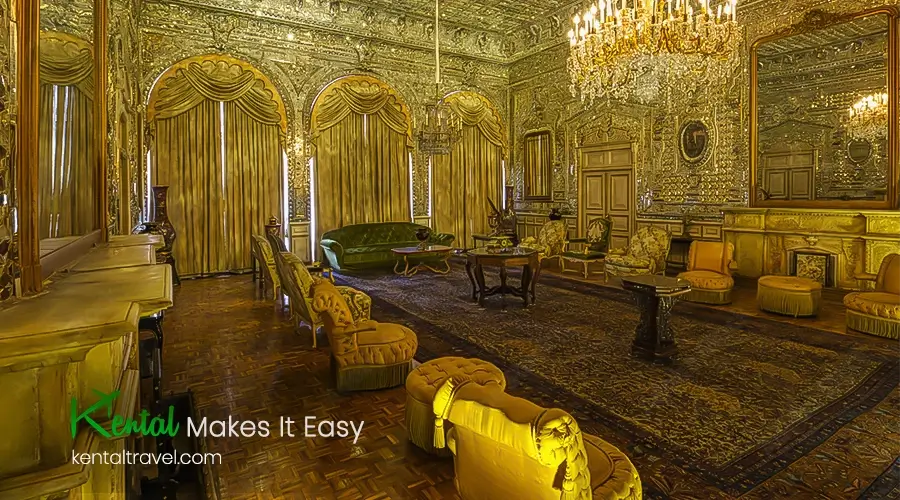
Golestan Palace, located in Tehran, is a historical gem that beautifully encapsulates the country’s rich history and architectural brilliance. This Iran historical place dates back to the 16th century, originally established during the Safavid dynasty. However, it was later extensively expanded and renovated under the Qajar rulers in the 19th century. The palace is a masterpiece of Persian architecture, blending traditional Persian designs with elements of European style. It boasts intricate tilework, stunning mirror halls, lush gardens, and exquisite painted ceilings. Each section of the palace reflects the distinct tastes and preferences of the rulers who contributed to its construction over the centuries.
Tabriz Historic Bazaar Complex

The Tabriz Historic Bazaar Complex in Tabriz is a captivating testament to centuries of trade, culture, and craftsmanship. This bazaar complex, dating back over a thousand years, has been a hub of commerce and cultural exchange along the Silk Road. The bazaar’s architecture showcases the ingenuity of Persian design, with intricate brickwork, vaulted ceilings, and elaborate tile decorations. It’s a labyrinthine network of covered passageways, shops, caravanserais, and mosques that exemplify the architectural prowess of different eras. The complex also played a significant role in shaping the city’s urban fabric and social life. Tabriz Historic Bazzar is a first UNESCO World Heritage Bazzar.
FAQs about Top Historical Attractions in Iran
- What is the most historical place in Iran?
One of the most ancient Iran historical places is the city of Persepolis. Persepolis, also known as Takht-e-Jamshid, was the ceremonial capital of the Achaemenid Empire and was built around 500 BC by King Darius the Great. It’s an archaeological marvel with monumental ruins, intricate carvings, and grand staircases that provide a glimpse into the opulence and power of ancient Persia. The site is a UNESCO World Heritage Site and holds immense cultural and historical importance in Iran’s history. - What is Iran’s oldest city?
Susa is considered one of Iran’s oldest cities, with a history dating back thousands of years. It was an important ancient settlement, serving as the capital of the Elamite Empire and later becoming a significant city under Persian rule. The archaeological ruins of Susa provide valuable insights into the early civilizations that flourished in the region, making it a truly historic and culturally significant site.

